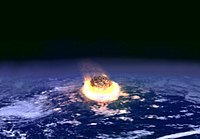
Photo from wikipedia
On the early Earth, oceanic plateaux similar to present-day Iceland are thought to have evolved into less dense microcontinents as they thickened by continued melt intrusion and crustal fractionation. These… Click to show full abstract
On the early Earth, oceanic plateaux similar to present-day Iceland are thought to have evolved into less dense microcontinents as they thickened by continued melt intrusion and crustal fractionation. These earliest continents may have been so weak on a hotter Earth that they collapsed laterally in response to thickening by further magmatic growth or tectonic imbrication. This continental spreading is likely to have resulted in the development of pervasive ductile strain fabrics in the deeper crust, which, if preserved, could generate seismic reflections. Here we present seismic images from the ancient core of the Archaean Yilgarn Craton of Australia that reveal shallowly dipping to horizontal reflections that pervade the middle and lower crust. We interpret these reflective fabrics as the result of widespread lateral crustal flow during the late stage of craton evolution approximately 2.66 to 2.61 billion years ago, which coincided with the widespread intrusion of high-temperature crustal melts, as thickened early continental crust collapsed. The consequent subsidence of large regions of the upper crust, including volcanic and sedimentary greenstone rocks, in the hanging walls of listric mid-lower crustal ductile flow fabrics caused these rocks to drop beneath the granitic melts rising towards the surface, and did not involve Rayleigh–Taylor instabilities within a mostly mobile crust.Seismic images of giant crustal-collapse structures preserved in the Yilgarn Craton, Australia, reveal that these structures may have formed over 2.5 billion years ago when the cores of continents were hot and weak.
Journal Title: Nature Geoscience
Year Published: 2018
Link to full text (if available)
Share on Social Media: Sign Up to like & get
recommendations!